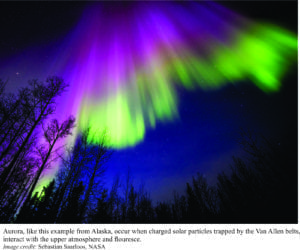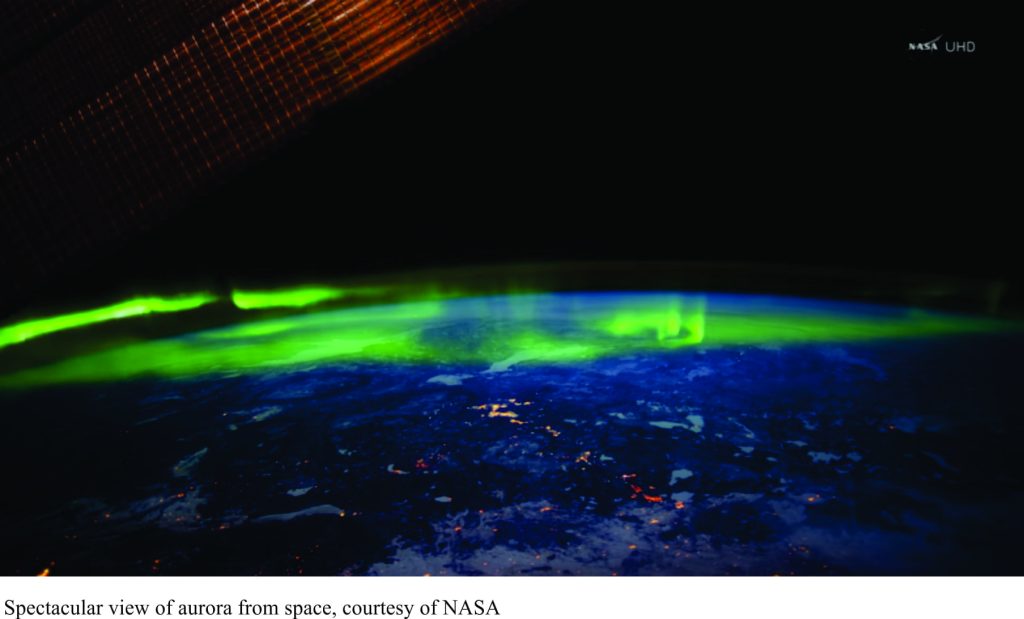“Archeomagnetic Jerks”. This interesting phrase refers, not to people, but to our global magnetic field; the one that protects us from incoming solar radiation and protects all those electrical devices we’ve come to rely on, including satellites. The magnetic field is generated by earth’s solid core; it envelopes our earth. The magnetic poles (not the same as the geographic poles), move around a bit. Measurements of the field over several decades indicate that the north magnetic pole is migrating south, towards Siberia and has moved about 1000 km since it was first pin-pointed in 1831. Geological investigations of ‘fossil’ magnetic fields also demonstrates that the magnetic field has flipped hundreds of times over past millennia, where north becomes south (see an earlier post for details). Disconcerting as this sounds, we can take some comfort in the fact that these polarity reversals do not coincide with any extinctions. Homo sapiens was around during the last reversal (780,000 years ago) and, I’m happy to report, survived intact. We will survive the next reversal, although some of the electrical accoutrements we have amassed, might not.
Earth’s magnetic field is generated by rotation, or convection of a liquid nickel-iron layer that surrounds the solid iron core; it is referred to as the liquid outer-core. The heat necessary to drive convection comes from the solid inner core; temperatures for the outer core range from about 2700C to 7700C. Movement of the liquid iron is also driven by forces generated by earth’s rotation, called coriolis forces. Convection in the outer core is not uniform, and variations in rotation, perhaps analogous to eddies, produce variations in the magnetic field. One region of significant variation in the magnetic field is the South Atlantic Anomaly (SAA), a relatively narrow band where magnetic field strength is much lower than expected; this region extends from central South America to central Africa.
The SAA is thought to evolve from complex interactions in earth’s liquid outer core beneath Africa and central South America. And although the SAA is considered by some as a possible harbinger of wholesale magnetic pole reversal, the extent of the anomaly has a more immediate impact because of the interaction between the magnetic field and the Van Allen radiation belts (these radiation belts were one of the first discoveries made by an orbiting satellite). The radiation belts (there are usually two concentric belts) are doughnut-shaped regions in space where charged particles from the sun are trapped as they interact with the magnetic field. In doing so, they protect us from incoming solar radiation. However, the radiation ‘doughnut’ is not oriented symmetrically with earth’s axis of rotation but is slightly off-kilter. This means that one part of the radiation belt comes very close to earth – in fact about 200-300 km, and this low region is what defines the shape of the SAA. An important consequence of the SAA is that solar radiation is significantly more intense over the extent of the anomaly; orbiting satellites that transit the region of the anomaly are fitted with protective shields to prevent failure of electrical systems. For example, Hubble Space Telescope passes through the anomaly 15 times a day.
Globally, the strength of the magnetic field has decreased about 15% in the last 200 years. The current scientific dilemma with the SAA is that it seems to be expanding as the magnetic field weakens. This observation, given voice by several media outlets, has led to some predicting dire consequences during an imminent magnetic field reversal. The problem here is that scientists do not know whether this weakening is an unusual event, or one that anomalies like the SAA cycle through from time to time. It is also not well understood whether the SAA is a relatively recent phenomenon that has been around for a few hundred years, or has persisted over much longer periods of time, perhaps waxing and waning in its extent.
In a recent study, Jay Shah and other geophysicists looked at the magnetic signatures in 46,000 to 90,000 year-old volcanic rocks from Tristan da Cunha. These isolated volcanic islands in the South Atlantic lie within the SAA and may provide records of older magnetic anomalies. They discovered at least 4 periods of significantly reduce magnetic intensity, and concluded that the SAA could be a persistent anomaly, or at least one that recurs from time to time. Although the results are preliminary, they suggest that decreasing field strength in the SAA may have happened before, but without wholesale field reversal (there have been no reversals in the last 90,000 years).
The idea that the SAA is a long-lived phenomenon has received an additional boost in a study of archeological materials by Vincent Hare and colleagues, who measured the preserved magnetic signatures in Iron Age mud from southern Africa. The archeomagnetic materials used in this study were burnt, or baked mud from various Iron Age facilities such as grain storage and hut floors (perhaps baked by cooking and heating fires). Mud baked above a certain temperature (known as the Currie Point) will retain the magnetic signatures present at the time, in much the same way as solidified volcanic rocks. Measurements on these materials show significant changes in the magnetic field intensity, between 1225AD and 1550AD, and an earlier period around 500 to 600 AD. Abrupt changes in field intensity like these are commonly referred to as archeomagnetic jerks.
Despite the ‘End is nigh’ approach taken by tabloids and other popular media to this scientific phenomenon, the actual science is equivocal. It appears that the South Atlantic (magnetic field) Anomaly is long lived – at least many 10s of thousands of years, and that the magnetic field intensity of the anomaly has waxed and waned several times. In this context, the current state of decay of the magnetic field both globally and in the SAA, may be nothing more than a repeat of other historical and prehistorical events. However, on a more sobering note, we are overdue a complete magnetic pole reversal. No doubt the geophysicists will keep us posted. In the meantime, if a pole reversal takes place tomorrow, you may have to get used to subtracting (or adding) 180o from your compass bearing to ensure you end up where you want to go.




